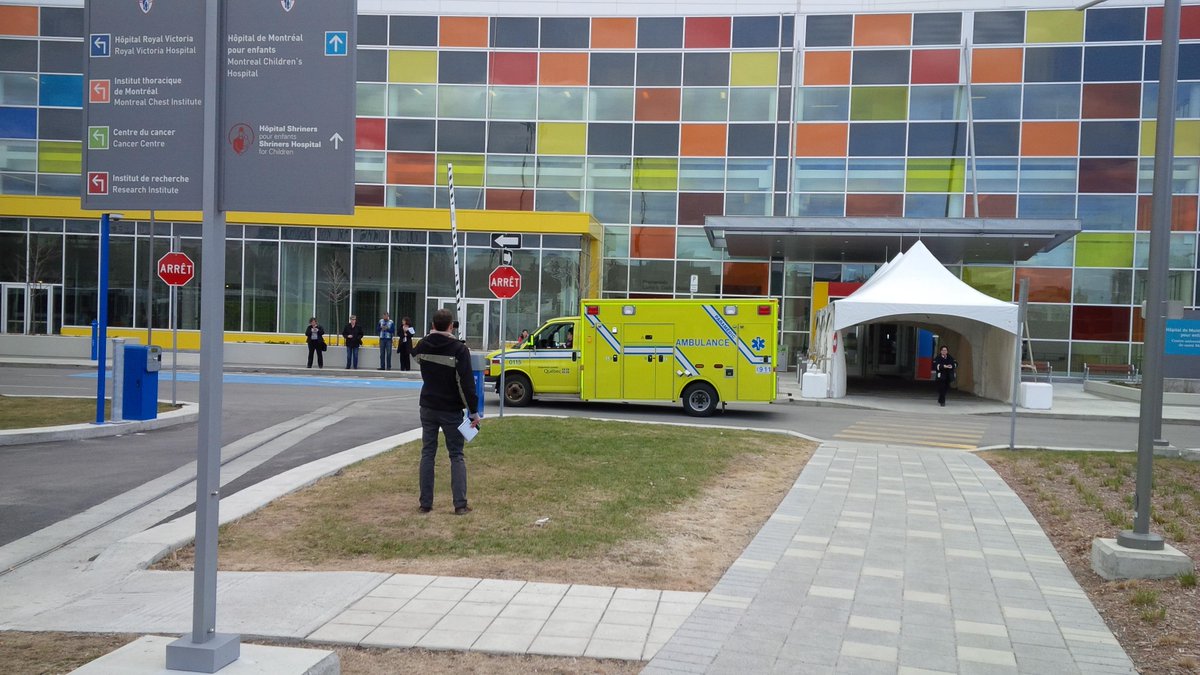
Few landmark institutions in Montreal have made as characteristic an imprint on the city's collective zeitgeist as the legendary Royal Victoria Hospital on Pine Avenue, which is finally closing down completely this afternoon. In what is the largest hospital relocation in Canadian history, today saw the transportation of some 154 patients (most estimates were considerably bigger - between 220 and 250) from the RVH down to the new MUHC Glen site.
I live extremely close to the old hospital so couldn't resist popping up to grab a little slice of history on what turned out to be a lovely, sunny, spring Sunday morning. The first thing that I noticed was how little fuss being made, with no sign of police or traffic control anywhere, and ambulances slipping seamlessly and quietly in and out of the RVH driveway with apparent military precision and ease. It was actually more tranquil than a typical day, which is something I imagine that was intentional and benefited the patients greatly.
Many reports had the move slated for something like 7am until 3pm (or later if need be) but in fact, so smooth was the procession of ambulances up and down Atwater to-and-from the RVH that the last and 154th patient arrived safely at MUHC by around 12:30PM, which underlines what was an incredibly organised process for what could have been a logistical nightmare! That is probably down to the chosen partner for this move, which was Health Care Relocations from Peterborough - an outfit renowned for transfer of hospitals from one site to another. Kudos to them and Team MUHC for what was an undoubted success.


On the picture at left above is patient #58 (there were already an impressive 57 patients safely arrived at the Glen site by 9:30am!) departing the RVH for their own very personal voyage and introduction to the new superhospital, while at right is the fleet of ambulances returning to RVH for their next pick-up. The pictures truly do tell the story of what was a very calm scene and if you didn't know better, you could have been forgiven for simply thinking that it was just a normal quiet Sunday morning at the hospital!
There was news from MUHC at the Glen site that became a perfect kickstart to the day just before the move commenced, and that was the birth at 6:55am of the very first baby born at the new site - a healthy 7.9lb boy. That may well turn out to be quite an historic birth, even if it might take a decade or two for it to sink in as far as he is concerned, but I wouldn't be surprised if he gets a ward named after him some day!
There were 2,500 hospital staff and volunteers, various medic vehicles, and a fleet of 32 ambulances that were involved in the move, and there are already celebrations going on after a glitch-free operation and smiles from patients arriving to what appeared to be "like hotel rooms" in comparison to their previous premises up the hill. Even as healthy adults, moving home is considered to be one of the most stressful events in our life, and I can only imagine what that means and feels like when it necessitates being moved from your hospital bed into totally unfamiliar surroundings.


As happy a day as it no doubt is, I am a huge fan of big old buildings like the RVH, and seeing it cleared out and closed down on a sunny Sunday after some 122 years in residence, perched on high above the cityscape, well, it was also a day tinged with nostalgia, memories and some pathos. Who knows how many lives passed through those doors, lives changed forever by illness and disease, many never exiting again, as well as the extended families who were transformed by events that transpired there. Over a century of medical and individual history swirling inside the corridors behind that greystone, as the big door gets closed and sealed for the very last time.
But you know, as one big door gets closed, so do many others swing open, which is exactly what happened at the new MUHC today, and collectively they represent one massive door opening on improved contemporary healthcare for Montrealers, for hopefully many generations to come. I just hope that as chic and modern as the new MUHC undoubtedly is, that the authorities demonstrate a desire to preserve the old hospital facade as a permanent reminder of its existence and service to the community, and don't permit its demolition and conversion into the pervasive and even seemingly inevitable installation of condominiums.
But that's a question and a problem for another day, and right now it's best to just marvel at our new superhospital and the settling in of those 154 former RVH patients as brand new MUHC-RVH patients! I had the privilege of visiting the unopened hospital last December (as reported in an earlier post on this blog) and it's clear that they are going to be exceptionally comfortable and well taken care of there. On that note, I shall leave you with a photograph of that last patient arriving at the Glen site shortly after noon today. Bravo to all @MUHC!




